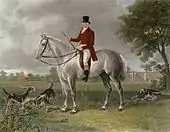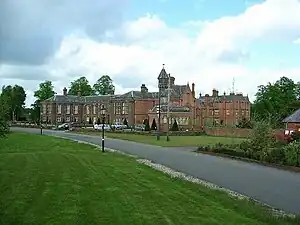
Thomas Cholmondeley, 1st Baron Delamere (/ˈtʃʌmli/; 9 August 1767 – 30 October 1855), was a British peer and Member of Parliament.[1][2]
Background

He was the son of Thomas Cholmondeley (1726–1779), Member of Parliament for Cheshire.[3] On his father's side he descended from a younger brother of Robert Cholmondeley, 1st Earl of Leinster, and Hugh Cholmondeley, father of Robert Cholmondeley, 1st Viscount Cholmondeley, from whom the Marquesses of Cholmondeley descend. His mother was Dorothy Cowper.[1] Delamere was an indirect descendant of Sir Robert Walpole, the first Prime Minister of Great Britain.[4]
The Cholmondeleys were long established at their seat at Vale Royal Abbey, Cheshire which had been in the family since 1615.[5]
Career
Cholmondeley served as High Sheriff of Cheshire in 1792 and then in 1796 was elected to the House of Commons for his father's old seat of Cheshire, which he retained until 1812. On 17 July 1821 he was raised to the peerage as Baron Delamere, of Vale Royal in the County Palatine of Chester.[6] The current baron, the 5th Baron Delamere, paints a picture of his early-19th-century ancestor with deft, harsh strokes:
- "[The 1st Baron Delamere] was an idiot who decided it would be impressive to have a peerage. He thought he had a bargain when he paid 5,000 for it. The only problem was that the going rate was 1,200. Before he came along we had been content to be shire knights in Cheshire, when William the Conqueror gave us the whole county."[7]
Family
On 17 December 1810, Cholmondeley married Henrietta Elizabeth Williams-Wynn, daughter of Sir Watkin Williams-Wynn, 4th Baronet, and his wife, Charlotte (née Grenville).[1] That union produced six children and numerous grandchildren:
- Hugh (3 October 1811 – 1 August 1887)[1] married Sarah Hay-Drummund, and later married Augusta Emily Seymour.[8]
- Thomas (4 January 1817 – 10 August 1817)[1]
- Thomas Grenville (4 August 1818 – 9 February 1883)[1] married Katherine Lucy Sykes, and later married Violet Maud Parker
- Henry Pitt (15 June 1820 – 14 April 1905)[1] married Mary Leigh
- Henrietta Charlotte (3 June 1823 – 13 August 1874), who married Henry Wilson, 11th Baron Berners.[1]
- Charles Watkin Neville (27 May 1826 – 18 March 1844).[1]—unmarried
The marriage of the baron's third son, Henry, produced nine grandchildren; and of these, Lionel would become chaplain to the British Embassy in Tokyo[9] and would write the first English-language history of the isolated Bonin Islands, including notes of changes which evolved after annexation by Meiji Japan in 1875.[10]
Cholmondeley died at age 88 in October 1855. He was succeeded in the land, estates and title by his eldest son Hugh Cholmondeley.[1]
See also
Notes
- 1 2 3 4 5 6 7 8 9 10 Lundy, Darryl. "1st Baron Delamere, ID #29417". The Peerage.
- ↑ History of Parliament Online: Cholmondeley, Thomas (1767–1855), of Vale Royal, Cheshire. Accessed Nov 2018.
- ↑ Cholmondeley, Thomas (1726–79), of Vale Royal, Cheshire. Accessed Nov 2018.
- ↑ Hayden, Joseph. (1851). The book of dignities, pp. 527, 565.
- ↑ Holland, G.D et al. (1977). Vale Royal Abbey and House, pp. 20–32; Westair-Reproductions: Cheshire, Museum finder
- ↑ "No. 17724". The London Gazette. 14 July 1821. p. 1462.
- ↑ Wright, Rupert "The Kennedys of Kenya," The Spectator (London). 11 April 1998.
- 1 2 3 4 5 6 7 8 9 10 William the Conqueror database
- ↑ Bibliography, Ogasawara (Bonin) Islands Archived 23 January 2011 at the Wayback Machine
- ↑ Cholmondeley, Lionel Berners. (1915). The History of the Bonin Islands from the Year 1827 to the Year 1876. London: Constable & Co.
References
- Debrett, John, Charles Kidd, David Williamson. (1990). Debrett's Peerage and Baronetage. New York: Macmillan. ISBN 978-0-333-38847-1
- Hayden, Joseph. (1851). The book of dignities: containing rolls of the official personages of the British Empire. London: Longmans, Brown, Green, and Longmans. OCLC 2359133
- Holland, G. D., et al. (1977). Vale Royal Abbey and House. Winsford, Cheshire: Winsford Local History Society. OCLC 27001031
- Ormerod, George; Helsby, Thomas (1882). The History of the County Palatine and City of Chester: Compiled from Original Evidences in Public Offices the Harleian and Cottonian Mss. Parochial Registers Private Muniments Unpublished Ms. Collections of Successive Cheshire Antiquaries and a Personal Survey of Every Township in the County ; Incorporated with a Republication of King's Hale Royal and Leycester's Cheshire Antiquities. Vol. 2 (2nd ed.). George Routledge and Sons. p. 158. OCLC 223243317.